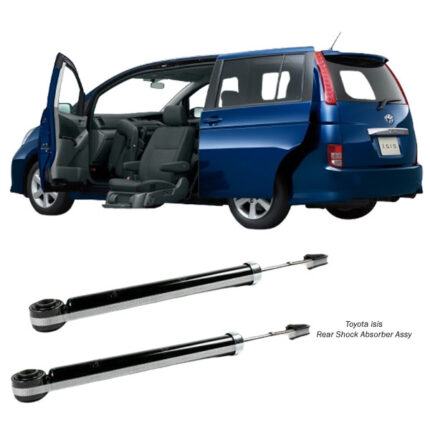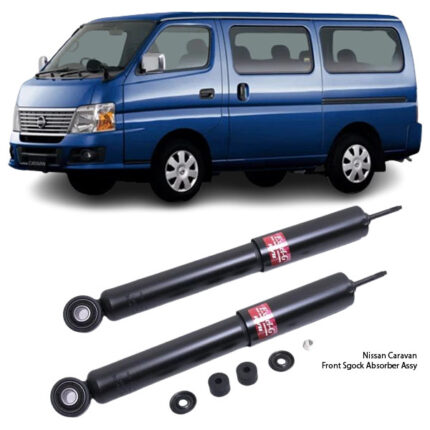-8%
Get Nissan Teana J32 Rear Shock Absorber Assy 348024 in Kenya
Ever walked on an uneven road with poorly cushioned shoes? Every bump feels bigger, every step unstable, and you’re constantly trying to regain balance.
That’s exactly what happens to any mechanical system when its Rear Shock Absorber Assembly isn’t doing its job. While it may seem like just a behind-the-scenes component, it’s one of the hardest-working parts — built to absorb punishment, maintain stability, and protect every connection from unnecessary strain.
Let’s dive into the story of this unsung hero — what it is, how it works, why it matters, and how to spot when it’s begging for attention.
🎯 What Is the Rear Shock Absorber Assy?
The Rear Shock Absorber Assembly is a hydraulic or gas-charged dampening unit designed to control up-and-down movement of the rear suspension.
Whenever motion causes vertical movement — from dips, bumps, potholes, or even speed humps — the shock absorber’s role is to slow, absorb, and control that motion before it transfers into the frame or cargo area.
Rather than supporting weight, its job is all about controlling movement. It’s a key player in the balance between comfort and control — and without it, everything feels chaotic. 💥
🧠 How It Works: From Chaos to Control
Imagine hitting a bump without shock absorbers. The suspension would bounce up and down uncontrolled, like a spring with no brakes.
The shock absorber contains:
-
A piston that moves through hydraulic fluid or gas
-
Valves that restrict flow, creating resistance
-
A sealed cylinder body that manages pressure and dampens energy
As the system compresses or extends, the shock absorber resists the movement, transforming kinetic energy into heat, which is then dissipated safely.
This smoothens out every bump, prevents bounce, and stabilizes the entire system during motion — especially at the rear, where load changes, cornering, or braking add even more complexity.
🌧️ Why the Rear Matters More Than You Think
Many people assume the rear suspension isn’t as important. But in reality, it handles load variation, traction under acceleration, and balance during braking — all of which rely heavily on rear dampers working properly.
A well-functioning Rear Shock Absorber Assembly means: ✅ Smoother rides, even when carrying extra load
✅ Reduced sway or drift during turns
✅ Better grip on uneven surfaces
✅ Less wear on tires and other suspension parts
✅ Enhanced braking stability
Whether you’re cruising, hauling, or navigating unpredictable terrain — this assembly is key to keeping things grounded. 🧲
🔍 Symptoms of Worn Rear Shock Absorbers
Because they degrade gradually, worn shocks are easy to ignore — until your entire system feels off. Here are some telltale signs that the rear shock absorbers are due for inspection or replacement:
🌀 Bouncy ride – Especially after dips or bumps
🎢 Rear-end float – The back feels loose or unstable
🛞 Uneven tire wear – Cupping or scalloping from constant bouncing
💧 Oil leaks – Visible seepage on the shock body
📉 Reduced braking performance – Rear end lifts or skids more under hard braking
⚠️ Knocking or clunking sounds – As the piston or bushings wear out
🔁 Longer stopping distance – Because the system can’t stabilize quickly
If you’re experiencing more than one of these, your rear shock absorbers are likely tired — and it’s time to swap them out. ⏱️
🔄 Why They Wear Out
Shock absorbers operate under extreme conditions. Every pothole, bump, and curve passes through them — often thousands of times a day.
Common causes of wear include:
-
🌧️ Water and dust contamination
-
🌡️ Heat breakdown of internal fluid
-
💨 Gas leakage in charged systems
-
🛑 Hard stops and heavy loads
-
🔩 Mounting point fatigue or bushing degradation
The harder the usage — like off-roading, heavy loads, or poor roads — the faster they’ll wear.
🛠️ What Happens During Replacement?
Here’s what a rear shock absorber replacement typically involves:
-
Elevating the system for safe access
-
Removing rear wheels to reach the shocks
-
Unbolting the old assembly from the frame and suspension arm
-
Inspecting mounting points, bushings, and nearby components
-
Installing new shock absorbers – matching length, type, and load rating
-
Torque tightening all bolts to spec
-
Test-driving to confirm improved response and damping
It’s a straightforward service — but it has a major impact on safety and ride quality. 🧰
🧩 Types of Rear Shock Absorbers
Not all shock absorbers are the same. Depending on the system, you might encounter:
-
Twin-tube shocks – Classic design, great for everyday use
-
Mono-tube shocks – Better heat dissipation, used for performance or heavier use
-
Gas-charged shocks – Nitrogen-filled to reduce aeration and improve response
-
Adjustable shocks – Tunable stiffness for varying loads or terrain
-
Electronic shocks – Integrated into smart suspension systems
Choosing the right type is important — especially for tuned performance or load-specific applications. 🧠⚙️
🧼 Maintenance Tips for Long Life
Rear shock absorbers aren’t serviceable internally — but you can help them last longer:
✔️ Avoid overloading
✔️ Drive cautiously on rough roads
✔️ Inspect shocks and mounts during regular service
✔️ Check tires – uneven wear often points to shock issues
✔️ Don’t ignore noises – they’re the system’s way of asking for help
✔️ Replace in pairs – for balanced performance
A good rule of thumb? If one is gone, the other’s not far behind. Replace both rear shocks together for the best results. 🔄🔧
🚀 The Payoff: A Better, Safer, Smoother Ride
Upgrading or maintaining your Rear Shock Absorber Assembly pays off instantly:
🌟 Smoother comfort over every surface
🛡️ Stronger protection for suspension parts
🚘 More stable handling, especially when loaded
🛑 Shorter braking distance and better grip
📈 Longer tire life, thanks to balanced motion control
It’s not just about performance. It’s about peace of mind. Confidence in every corner. Comfort with every haul. Control on every road.
🧭 Final Thoughts: Built to Absorb, Designed to Deliver
The Rear Shock Absorber Assy may work behind the scenes — but it carries the weight of comfort, safety, and balance on its back. It’s the difference between a system that flows and one that fights back. Between smooth sailing and a constant shake.
So if the ride feels off…
If the back sways a little too much…
If the bumps hit harder than before…
It might be time to show this silent hero some love.
Because when your shocks work hard, everything else works better.
Follow us on Facebook for more parts.



